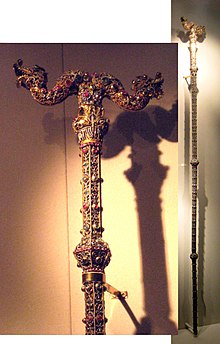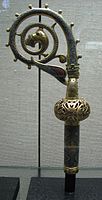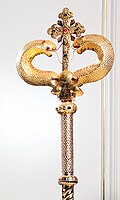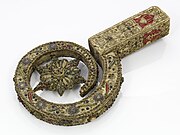Crozier
This articleneeds additional citations forverification.(January 2017) |

Acrozierorcrosier(also known as apaterissa,pastoral staff,orbishop's staff)[1]is a stylized staff that is a symbol of the governing office of abishoporabbotand is carried by high-rankingprelatesofRoman Catholic,Eastern Catholic,Eastern Orthodox,Oriental Orthodox,Malankara Mar Thoma Syrian Church,and someAnglican,Lutheran,United MethodistandPentecostalchurches.
InWestern Christianitythe crozier typically takes the form of ashepherd's crook,a tool used to manage flocks of sheep and herds of goats. InEastern Christianity,the crozier has two common forms:tau-shaped, with curved arms, surmounted by a small cross; or a pair of sculptured serpents or dragons curled back to face each other, with a small cross between them.
Other typical insignia of prelates are themitre,thepectoral cross,and theepiscopal ring.
History
[edit]The origin of the crozier as a staff of authority is uncertain, but there were many secular and religious precedents in the ancient world. One example is thelituus,the traditional staff of the ancient Romanaugurs,[2]as well as theStaff of Mosesin theHebrew Bible.Many other types of thestaff of officewere found in later periods, some continuing to the modern day in ceremonial contexts.[citation needed]
In theWestern Church,the usual form has been ashepherd's crook.This relates to the many metaphorical references to bishops as the shepherds of their "flock" of Christians, following the metaphor of Christ as theGood Shepherd.[citation needed]
The Eastern Orthodox and Eastern Rite Catholic crozier is commonlytau-shaped, with curved arms and surmounted by a small cross, or with a pair of sculptured serpents or dragons on top, curled back to face each other, and a small cross between them. The symbolism in the latter case is of the bronze serpent,Nehushtan,made byMosesas related inNumbers 21:8–9.It is also reminiscent of the rod of the ancient Greek godAsclepius,whose worship was centered around the Aegean, including Asia Minor, indicating the role of the bishop as healer of spiritual diseases.[citation needed]
Staff of Moses
[edit]TheStaff of Mosesis first mentioned in theBook of Exodus(chapter 4, verse 2), when God appears toMosesin theburning bush.God asks what Moses has in his hand, and Moses answers "a staff" ( "a rod" in theKing James Version). The staff is miraculously transformed into a snake and then back into a staff. The staff is thereafter referred to as the "rod of God" or "staff of God" (depending on the translation).
"And thou shalt take this rod in thine hand, wherewith thou shalt do signs." And Moses went and returned to Jethro, his father in law, and said unto him, "Let me go, I pray thee, and return unto my brethren which are in Egypt and see whether they be yet alive." And Jethro said to Moses, "Go in peace." The LORD said unto Moses in Midian, "Go, return into Egypt: for all the men are dead which sought thy life." And Moses took his wife and his sons and set them upon an ass; and he returned to the land of Egypt: and Moses took the rod of God in his hand.
Moses andAaronappear before thePharaoh of the Exodus,whenAaron's rodis transformed into a serpent. The Pharaoh's sorcerers are also able to transform their own rods into serpents, but Aaron's swallows them. Aaron's rod is again used to turn theNileblood-red. It is used several times on God's command to initiate thePlagues of Egypt.
Duringthe Exodus,Moses stretches out his hand with the staff topart the Red Sea.While in the wilderness after leaving Egypt, Moses does not follow God's command to "speak ye unto the rock before their eyes", instead he strikes the rock with the rod to create a spring for the Israelites from which to drink. Because Moses did not sanctify God before them but said "Hear now, ye rebels; must we fetch you water out of this rock?" Thus, Moses failed by honoring himself and not God. For not doing what God commanded, God punished Moses by not letting him enter into thePromised Land(Book of Numbers20:10–12).
Finally, Moses uses the staff in the battle atRephidimbetween the Israelites and theAmalekites.When he holds up the "rod of God", the Israelites "prevail". When he drops it, their enemies gain the upper hand. Aaron andHurhelp him to keep the staff raised until victory is achieved.[citation needed]
Official use
[edit]
The crozier is the symbol of the governing office of abishop,abbot,orApostle.
Western Christianity
[edit]InWestern Christianity,the crozier (known as the pastoral staff, from the Latinpastor,shepherd) is shaped like ashepherd's crook.A bishop or church head bears this staff as "shepherd of the flock of God", particularly the community under his canonical jurisdiction, but any bishop, whether or not assigned to a functional diocese, may also use a crozier when conferringsacramentsand presiding atliturgies.The CatholicCaeremoniale Episcoporum[3]says that, as a sign of his pastoral function, a bishop uses a crozier within his territory, but any bishop celebrating the liturgy solemnly with the consent of the local bishop may also use it. It adds that, when several bishops join in a single celebration, only the one presiding uses a crozier.[citation needed]
A bishop usually holds his crozier with his left hand, leaving his right hand free to bestowblessings.The Caeremoniale Episcoporum states that the bishop holds the crozier with the open side of the crook forward, or towards the people. It also states that a bishop usually holds the crozier during aprocessionand when listening to the reading of the Gospel, giving a homily, accepting vows, solemn promises or a profession of faith, and when blessing people, unless he must lay his hands on them. When the bishop is not holding the crozier, it is put in the care of analtar server,known as the "crozier bearer", who may wear around their shoulders a shawl-likeveilcalled avimpa,so as to hold the crozier without touching it with their bare hands. Another altar server, likewise wearing a vimpa, holds themitrewhen the bishop is not wearing it. In theAnglicantradition, the crozier may be carried by someone else walking before the bishop in a procession.[citation needed]
The crozier is conferred upon a bishop during hisordinationto theepiscopacy.It is also presented to anabbotat his blessing, an ancient custom symbolizing his shepherding of themonastic community.Although there is no provision for the presentation of a crozier in the liturgy associated with the blessing of anabbess,by long-standing custom an abbess may bear one when leading her community ofnuns.[citation needed]
The traditional explanation of the crozier's form is that, as a shepherd's staff, it includes a hook at one end to pull back to the flock any straying sheep, a pointed finial at the other tip to goad the reluctant and the lazy, and a rod in between as a strong support.[citation needed]
The crozier is used inecclesiastical heraldryto represent pastoral authority in thecoats of armsofcardinals,bishops, abbots and abbesses. It was suppressed in most personal arms in the Catholic Church in 1969, and is since found on arms of abbots and abbesses, diocesan coats of arms and other corporate arms.
In theChurch of God in Christ,the largestPentecostalchurch in the United States, thepresiding bishopbears a crozier as a sign of his role as positional and functional leader of the Church.[citation needed]In somejurisdictionsof theUnited Methodist Church,bishopsmake use of croziers at ceremonial events.[4]
Papal usage
[edit]
Popesno longer carry a crozier and instead carry thepapal ferula.In the first centuries of the church, popes did carry a crozier but this practice was phased out and disappeared by the time ofPope Innocent IIIin the thirteenth century. In the Middle Ages, much as bishops carried a crozier, popes carried apapal crosswith three bars, one more than the two bars found on croziers carried before archbishops in processions (seearchiepiscopal cross). This too was phased out.Pope Paul VIintroduced the modern papal pastoral staff, the papal ferula, in 1965. He and his successors have carried a few versions of this staff, but never a crozier.
Eastern Christianity
[edit]
InEastern Christianity(Oriental Orthodoxy,Eastern OrthodoxyandEastern Catholicism), bishops use a similar pastoral staff. When a bishop isconsecrated,the crozier (Greek:paterissa,Slavonic:pósokh) is presented to him by the chief consecrator following the dismissal at theDivine Liturgy.
TheArchbishop of Cyprushas the uniqueprivilege in canon lawof carrying apaterissashaped like an imperialsceptre.This is one of theThree Privilegesgranted to theOrthodox Church of Cyprusby Byzantine EmperorZeno(the other two being to sign his name incinnabar,i.e., ink colouredvermilionby the addition of the mineral cinnabar, and to wear purple instead of blackcassocksunder his vestments).[citation needed]
An Easternarchimandrite(high-ranking abbot),hegumen(abbot) or hegumenia (abbess) who leads a monastic community also bears a crozier. It is conferred on them by the bishop during the Divine Liturgy for the elevation of the candidate. When he is not vested for worship, a bishop, archimandrite or abbot uses astaff of officetopped with a silver pommel.[citation needed]
Oriental Orthodoxy
[edit]
In theOriental Orthodoxchurches, croziers are used as pastoral staffs held by bishops. TheArmenian Apostolic Churchuses both Eastern- and Western-style croziers, while theSyriac Orthodox ChurchandIndian Orthodox Churchhave croziers that are thicker than their Eastern counterparts. Clerics of theEthiopian Orthodox Tewahedo Churchand theEritrean Orthodox Tewahedo Churchuse croziers that look exactly like the Greek ones.[citation needed]
In theCoptic Orthodox Church of Alexandria,croziers are sometimes somewhat longer and are always decorated with a bloodredcloth around the top cross and the serpents. This symbolizes the bishop's responsibility for the blood of his flock.[citation needed]
Description
[edit]Croziers are often made or decorated in precious metals, or are at leastgildedor silver-plated. Underneath, the core and shaft is often wood, and some are entirely made of wood, though this is more common for croziers carried by abbots rather than bishops.Ivory,from thewalrusor elephant, was often used in the Middle Ages.[citation needed]
Western croziers
[edit]Croziers used by Western bishops have curved or hooked tops, similar in appearance to staves traditionally used byshepherds,hence they are also known ascrooks.In some languages there is only one term referring to this form, such as the GermanKrummstabor Dutchkromstaf.The crook itself (i.e., the curved top portion) may be formed as a simple shepherd's crook, terminating in a floral pattern, reminiscent of theAaron's rod,or in a serpent's head. It may encircle a depiction of the bishop'scoat of armsor the figure of a saint. In some very ornate croziers, the place where the staff meets the crook may be designed to represent a church.[citation needed]

Insular croziers,produced in Britain and Ireland in theEarly Middle Ages,have a more simple shape, perhaps closer to actual shepherd's crooks. They were regarded as importantrelicsof church leaders, and have survived in untypical numbers, including theClonmacnoise Crozier,Kells Crozier,Lismore Crozier,Prosperous Crozier,River Laune Crozier,St. Columba's Crozier,St. Fillan's Crozier,andSt. Mel's Crozier.
In previous times, a cloth of linen or richer material, called thesudarium(literally, "sweat cloth" ), was suspended from the crozier at the place where the bishop would grasp it. This was originally a practical application which prevented the bishop's hand from sweating and discolouring (or being discoloured by) the metal. The invention ofstainless steelin the late 19th century and its subsequent incorporation in material used for croziers rendered moot its original purpose and it became more elaborate and ceremonial in function over time.[citation needed]Inheraldry,thesudariumis often still depicted when croziers occur on coats of arms.
In the Roman Catholic Church, the crozier is always carried by the bishop with the crook turned away from himself; that is to say, facing toward the persons or objects he is facing, regardless of whether he is theOrdinaryor not. TheSacred Congregation of Riteson 26 November 1919, stated in a reply to the following question,
In case an outside Bishop uses a Bishops' staff, this being either required by the function or permitted by the Ordinary, in what direction should he hold the upper part, or crook? Reply.Always with the crook turned away from himself, that is toward the persons or objects which he is facing. (AAS 12-177)
Eastern croziers
[edit]The croziers carried by Eastern bishops,archimandrites,abbots and abbesses differ in design from the Western crozier. The Eastern crozier is shaped more like a crutch than a shepherd's staff.
Thesudariumor crozier mantle is still used in the Eastern churches, where it is usually made of a rich fabric such as brocade or velvet, and usually embroidered with a cross or other religious symbol, trimmed with galoon around the edges and fringed at the bottom. Thesudariumis normally a rectangular piece of fabric with a string sewn into the upper edge which is used to tie thesudariumto the crozier that can be drawn together to form pleats. As the sudarium has grown more elaborate, bishops no longer hold it between their hand and the crozier, but place their hand under it as they grasp the crozier, so that it is visible.[citation needed]
Gallery
[edit]-
Copy of the Aghadoe Crozier,Swedish History Museum,Stockholm. Originating fromAghadoe,County Kerryin the early 12th century, the crozier is formed from a single block ofWalrusivory,and contains a spiral design on the crook showing the head of an animal biting a human figure.[5]
-
Walrus tusk,Holy Spiritas a dove, England, ca. 1120–1130,Musée national du Moyen Âge,Paris
-
Crozier head with floral cluster, English, late 12th century[6]
-
Ivory crozier showing theAgnus Dei,Italy, 13th century,Musée du Louvre
-
A traveling crozier, covered with embroidered fabric, 16th century, Czech Republic.Jagiellonian University Museum
See also
[edit]Notes
[edit]- ^Chisholm, Hugh,ed. (1911)..Encyclopædia Britannica.Vol. 7 (11th ed.). Cambridge University Press. p. 520.
- ^Morrisroe, Patrick (1908)..In Herbermann, Charles (ed.).Catholic Encyclopedia.Vol. 4. New York: Robert Appleton Company.
- ^Caeremoniale Episcoporum (Vatican Polyglott Press, 1985), 59
- ^"The Bishop's Staff".moumethodist.org.Missouri Annual Conference of the United Methodist Church. 20 October 2016.Retrieved25 July2022.
- ^Moss (2014), p. 314
- ^"Crosier head".National Museum of Scotland.Retrieved 20 August 2021
References
[edit]- Morrisroe, Patrick (1908)..In Herbermann, Charles (ed.).Catholic Encyclopedia.Vol. 4. New York: Robert Appleton Company.
- "Crosier",Merriam-Webster Online Dictionary,Springfield, MA: Merriam-Webster, Inc., 2005, archived fromthe originalon 18 December 2007,retrieved28 July2003
- Moss, Rachel.Medieval c. 400—c. 1600: Art and Architecture of Ireland.New Haven, CT: Yale University Press, 2014.ISBN978-0-3001-7919-4
- Noonan, James-Charles Jr. (1996),The Church Visible: The Ceremonial Life and Protocol of the Roman Catholic Church,New York: Viking, p. 191,ISBN0-670-86745-4
- Sybille Schneiders:Baculus pastoralis. Bischofs- und Abtstäbe des 5. bis 12. Jahrhunderts in Irland und auf dem Kontinent: Typologie und Chronologie – Herkunft und Verbreitung – Besitzer und Gebrauch.Freiburg i. Brsg. 2017https://freidok.uni-freiburg.de/data/15776.
- "The Reichenau Crozier".Metalwork.Victoria and Albert Museum.Archived fromthe originalon 28 November 2009.Retrieved22 September2007.
External links
[edit]- Braun, Joseph (1911)..Encyclopædia Britannica.Vol. 20 (11th ed.). pp. 898–899.




![Copy of the Aghadoe Crozier, Swedish History Museum, Stockholm. Originating from Aghadoe, County Kerry in the early 12th century, the crozier is formed from a single block of Walrus ivory, and contains a spiral design on the crook showing the head of an animal biting a human figure.[5]](https://upload.wikimedia.org/wikipedia/commons/thumb/b/b8/Aghadoe_Crozier_%28copy%29.jpg/180px-Aghadoe_Crozier_%28copy%29.jpg)


![Crozier head with floral cluster, English, late 12th century[6]](https://upload.wikimedia.org/wikipedia/commons/thumb/2/2a/National_Museum_of_Scotland_%2827850492657%29.jpg/180px-National_Museum_of_Scotland_%2827850492657%29.jpg)

